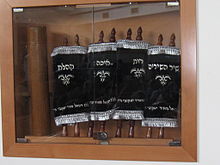- Megillot
-
Megillot (pl. zu hebr. מְגִלָּה megilla, „Buchrolle“, „Buch“) ist im Judentum die Bezeichnung für fünf Schriften aus dem Tanach. Sie gehören zum dritten Teil der hebräischen Bibel, den Ketubim („Schriften“). Die fünf Bücher Rut, Hoheslied, Kohelet, Klagelieder und Ester werden den wichtigsten fünf Festen Schawuot, Pessach, Sukkot, Tischa beAv und Purim zugeordnet und daher auch als „Festrollen“ bezeichnet.
Inhaltsverzeichnis
Stellung in der Bibel
Die Zusammenstellung der Megillot als den fünf Festrollen ist erst seit dem 6. Jhdt. belegt. Spätestens seit dem 12. Jhdt. entspricht die Reihenfolge auch der Abfolge der jüdischen Feste im Jahreskreis. In talmudischer Zeit (bBB 14b) wurden die Bücher noch nach dem Alter der in ihnen beschriebenen Ereignisse in die Reihe der Ketubim eingeordnet: Rut-Psalmen-Ijob-Sprichwörter-Kohelet-Hoheslied-Klagelieder-Daniel-Ester-Esra-Chronik. Nach dem Codex Leningradensis (1008 n. Chr.) als der ältesten vollständigen masoretischen Bibelhandschrift finden sich die Megillot gemeinsam hinter den Büchern Chronik-Psalmen-Ijob-Sprüche und vor dem Buch Daniel.
Das christliche Alte Testament kennt zwar alle fünf Schriften, ordnet sie jedoch nicht zusammen. Die Reihenfolge orientiert sich an den Inhalten der Bücher und der in ihnen geschilderten Ereignisse: Rut (nach Richter) und Ester (nach Esra bzw. Judit) werden den Geschichtsbüchern zugeordnet, während Kohelet und Hoheslied (nach Sprichwörter) zu den Lehrbüchern zählen. Klagelieder wird unter den Propheten dem Buch Jeremia nachgestellt, der traditionell als sein Autor gilt. Das Alte Testament folgt mit dieser Abfolge weitgehend der Septuaginta.
Sonstiges
Der Traktat Megilla aus der Mischna beschäftigt sich ausschließlich mit dem Buch Ester.
Literatur
Georg Gafus, Art. Megillot, in: Neues Bibellexikon Band II, Zürich, Düsseldorf 1995, Sp. 753 ISBN 3545230759
Weblinks
Wikimedia Foundation.

